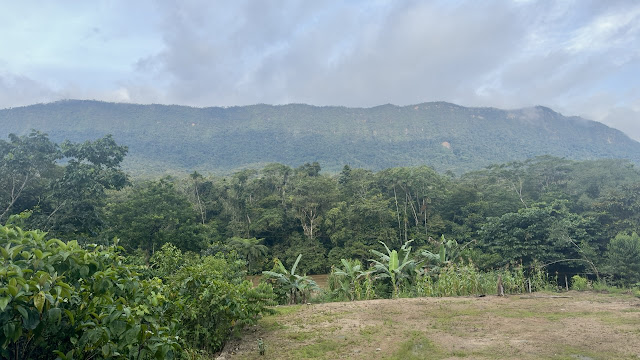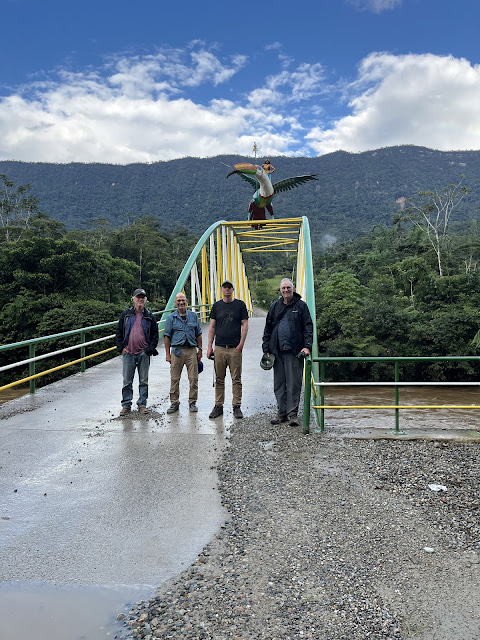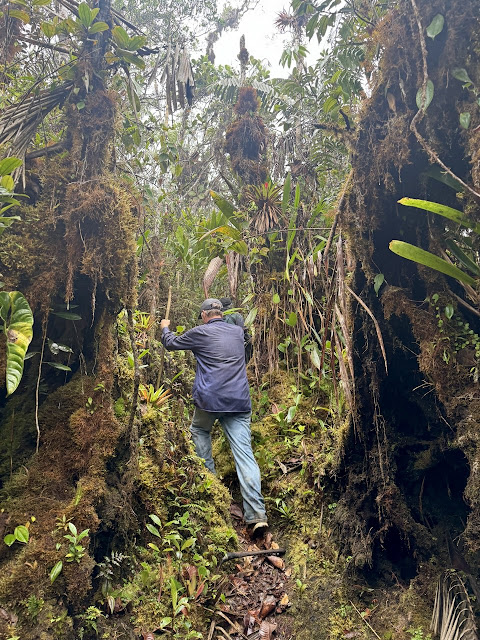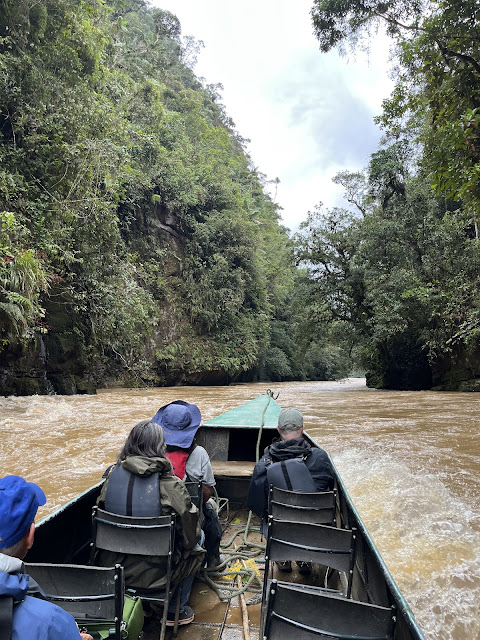THE CORDILLERA DEL CONDOR
In SE Ecuador is a mountain range named the Cordillera Del Condor. Translated it means “Mountain Range of the Condor.” These extend into Northern Peru, and are home to a few birds of interest, and as far as Ecuador goes, they are the only place in the country to find a few resident Ecuadorian birds. From Yankuam one can see the part of the ridge just north of the Peruvian border.
 |
| THE CORDILLERA FROM THE LODGE |
 |
| THE CORDILLERA IN THE BACKGROUND. WE ARE AT THE BRIDGE FROM RIGHT TO LEFT TIM, AARON, CHARLIE AND ME. HOW DO YOU LIKE THAT CHARACTER RIDING ON THE TOUCAN? |
When my wife and I were here 2 years ago, I learned that the beautiful Royal Sunangel could be seen “up” there. The male of this species of Hummingbird is all deep purple, and so certainly named appropriately, purple being the historic color for royalty. I wondered if I’d ever have occasion to go up there.
During dinner on the eve of our first full day of birding the Maycu Reserve and beyond, Christian, our bird guide, began egging us on to go up there in the morning. I was not going to consider that because I knew Charlie and Tim would certainly not want to tackle it. I felt like I’d be somewhat abandoning them at the lodge for a morning should Aaron and I embark on that hike. I was not so sure I wanted to tackle it either.
I tried to pump Christian for more information about the jaunt, but due to shortcomings in language communication, it was unclear about what I’d really be in for. So I went over to have a chat with Nelson, the bilingual bird guide who was there with 2 chaps from Britain. After pumping him with questions I learned the following important info for making the decision: The last 300 meters or so were very steep and you’d have to clamber on all fours, grabbing on to vines and roots to pull yourself along. It would be wet and muddy. It would take about an hour and a half, excluding stops for birding. I was NOT thrilled with such prospects, but both Tim and Charlie were OK to be left birding and photographing on their own, and Aaron was agreeable to haul my daypack, so I figured it was now or never. At 70 I’m not getting any younger. I would have liked to impose upon Aaron to haul my camera gear, but an additional 6.5 lbs was just not in the cards.
It was not a clear day at dawn, at all. The ridge was not even visible, so it would be a wet jaunt. We ate a hefty breakfast and were off. Carlos had made Aaron and me walking sticks, which turned out to be life savers. It turned out that Nelson and the two Brits were going to start on the same trail to “see how it went.” We met them a couple hundred feet along the trail where they were listening to some Marbled Wood Quail.
The trail was dark with drops of water falling from the wet leaves. As we ascended higher little by little, we’d hear occasional birds, but getting a visual on them was rare. Christian had explained that the birding was best in the intermediate range, just before the “final ascent.” It turned out he was right. In the space of about 200 meters we heard, and then saw, many of the following: Rufous-breasted Wood-Quail, Ruddy Pigeon, Green-backed and Blue-crowned Trogons, Purplish Jacamar, Plain-winged Antshrike, White-flanked (#400) and Rusty-winged Antwrens, Black, Gray, White-browed, Black-faced, Zimmer’s and Spot-backed Antbirds, Buff-throated Woodcreeper and a Bar-winged Wood-wren.
I suppose tallying these birds was motivation for what followed as we soon reached the steep area. There were roots all over the place and you’d have to pick your way along, placing each step in an appropriate place for the foothold. There were places where you could bounce yourself on the roots, as if they were spring loaded. And every 3rd or 4th time you placed a walking stick in the ground, it would go down a foot or two below the roots. Leaves and other debris often covered a hole, and you’d only find that out the hard way. At one point there was a tiny creek marking the “trail.” But the roots also served as “hand rails” to grab onto to pull yourself along. I supposed seeing a Royal Sunangel was going to be worth it, but concluded long before I would reach the top that if we did not see one, I’d not be returning for a second attempt.
At one point we heard Aaron yelp, and we looked back to see he had fallen into a hole just large enough to swallow him up to his hips! Am glad I missed it. But I’d step into a hole here and there up to my ankles and let Aaron know to avoid it. Every so often we’d stop and guzzle down water and let our heart beats return to “normal.” Oh, and did I mention we were sweating like pigs due to the humidity? At one stop we’d conjecture on descending, and if it would be more difficult than going up.
After what seemed long enough to have reached the top, we asked Christian how much farther it was, and he said “20 meters.” I am not sure if he really knew or if he was relaying the short distance to motivate us, but I was happy to see that he was correct. The trees got shorter and the gray sky became more visible. It would still be another hundred meters to the top, but at least for now the going was easier as the “edge” of the ridge was rounded.
It was eerily weird on top. I just wish it was clear so we could have seen more. It was certainly a “cloud forest” with bromeliads and moss everywhere. Christian was in front, me second and Aaron third almost all the way up. As we rounded a corner right after reaching the top, Christian called out, “Royal Sunangel!” Wow, there he was in all his glory. We did not have to wait it out for one to show up. I could have turned around right then and there because the mission was accomplished.
 |
| WE WERE ALL THUMBS UP CELEBRATING |
 |
| CHRISTIAN’S PHOTO |
 |
| THIS SHOT WAS UP TOP |
The bird stayed perched for us to enjoy for a minute or two, and then flew off. After a few high-fives we walked farther. In another 50 meters we saw a 2nd Royal Sunangel! This one soon flew to a different perch where the lighting was better, and Christian dug out his camera for a few pics.
We were really on “cloud 9” now. This bird stayed perched for some 3 minutes for us to enjoy. After he flew off, we hashed over what else would be a good find up here. The next best bird would be the Subtropical Pygmy Owl. So Christian played a few toots on his phone, and one responded immediately. Wow! The #2 target now landed on our list. But after a couple of minutes of playback, it was apparent he was not going to come in for a visual. But that was OK. We had our fill and it was soon time to descend.
Soon we reached the decline on the side of the ridge, and really had to watch where we placed our feet. Going up it was physically demanding, but going down an important mental component was necessary. We had to calculate every step. Would this root hold us or not? A couple times my foot went through the roots and I’d start falling forward, and luckily there was something to catch my fall. It would have been easy to break an ankle under the circumstances.
It was very welcome to reach the area where it was less steep and we were on “Tierra Firme,” where there was actually bare dirt beneath our feet. Usually my knees can handle such a decent, but they were sure feeling it now. I still had my walking sticks which really helped. I don’t remember what birds we heard on the way down, and frankly did not care. I was exhausted and all I cared about was reaching the road. We again ran into Nelson and company and briefly described our success, and were then continuing downhill. I finally heard a vehicle on the road below, so knew the end was to soon be in sight.
And reach the road we did. We had that feeling of being completely worn out but well satisfied. Our clothes were wet and muddy, so we placed our rain gear on the seats of the car to keep them clean. Once back we relayed our success to Tim and Charlie, and found out they had some good successes of their own, taking pictures of birds around the lodge. The 3 of us hit the showers. As I write this two days later, my legs are still sore, but my spirits are high. I doubt I’ll ever embark on another similar adventure like that, but……. you never know.













































